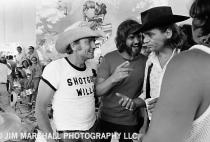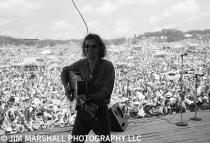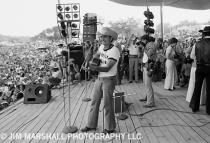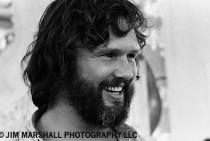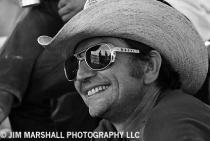An outdoor music festival in the dusty, white-hot heat of Texas in July? Willie Nelson’s reprise of the Dripping Springs Reunion in 1973 was supposed to be a “country Woodstock,” the launch pad for hippies and rednecks to do the whole “kumbaya” thing, musically, socially, and whatever other which way.
Instead, what this sun-baked country music party really launched was the “Outlaw” movement in country music led by Willie Nelson, Waylon Jennings and Kris Kristofferson, among others. And Willie’s Picnic has been a more or less annual, inspiring, brain-frying musical happening ever since.
I have to confess that Jim’s love of country music pretty much escaped me back in the day; it was the early ’80s, after all. So I don’t have a lot of personal memories to share with “you all,” but I do recall there was one “country” quirk of his that drove me a bit mad but also always made me smile.
It was almost a ritual with Jim, he’d have a few sips of his favored whiskey of the moment and there it would be: a rather pronounced twang in his voice, and off we’d go, him quoting Kristofferson and Billy Joe Shaver lyrics, his eyes getting moist, his hands a bit twitchy. When Jim was like that it was always such a perfect combo of bravado and misery, him reveling in his “dark times” with just enough levity and vision to see that the light at the end of the tunnel most likely was an oncoming train.
As always, when I’m stumped for specific Jim recollections or personal insights, I turn to those folks on the web that are expert in the subject and, after some searching about, I thankfully came upon a bit of an info mother lode.
In a blog entry on savingcountrymusic.com, someone with the moniker “triggerman” makes the case for how this 1973 coming together catalyzed by a bunch of Texans is as good a date as any to tag as the birth of the “Outlaw movement” in country music:
“Being a country music Outlaw has nothing to do with having tattoos. It has nothing to do with motorcycles, or how much you cuss in your music or reference drugs. It has nothing to do with rock influences in your music, nothing to do with if you “party” a lot or live an “Outlaw” lifestyle. Being an Outlaw has very little to do with the music itself. You can play traditional country, neo-traditional country, country-rock. There is NO definable Outlaw country sound. As long as it is country music, it can be Outlaw music.
“Outlaw” is a business term more than anything. Yes, all the above can be and have been elements of the overall Outlaw culture, but neither Willie, Waylon, or Kris had tattoos, rode motorcycles, and none of them were big drinkers. What they had in common with Outlaws that WERE big drinkers like Johnny Paycheck, or that rode motorcycles and had tattoos like David Allan Coe, was that they had all fought for creative control of their music from the country music establishment, and won it. THAT is what makes a country music artist an Outlaw.”
And from the Austin Statesman's history of the Picnics: “Willie was unfazed that the Dripping Springs Reunion had lost money. He wanted his own outdoor festival and, as March had already passed by, settled on the Fourth of July. He returned to the Dripping Springs ranch that had hosted the Reunion, this time bringing 40,000 hippies, rednecks and the rest of the Willie crowd. The Picnic lost money, but launched a Texas tradition.
“Journalist Jan Reid paints a broad picture of the Picnic in his book: ‘The Improbable Rise of Redneck Rock,’ (m3 note: this book is a must-read if you want to truly understand the importance of these events) but Billy Porterfield said it shorter in a 20-year look back in the Statesman: “It was miserable and it was great, one of the glorious heathen stomps between the Americas of J. Edgar Hoover, Joe McCarthy and Ronald Reagan. Many had come the evening before and spent the night passing stories and hits around campfires.”
More on upcoming "Jack & Jim" exhibit
In fact, Jan Reid’s 1974 “Redneck Rock” book mentioned earlier in this blog is often given credit for inspiring the nationally popular and long-running PBS series “Austin City Limits,” which turns a much-deserved spotlight on the Austin music scene that gave birth to, and still nourishes, the spirit of camaraderie and collaboration that Jim so wonderfully captured in these photos.
Speaking of, the “Jack & Jim” permanent 30-print exhibition, which will officially launch this Sept. 14 at a gallery at Austin City Limits' new live venue, promises to be a one-of-a-kind event, with Carlos Santana (longtime dear friend of Jim’s) on the bill that night. Check out this great, and surprisingly moving, video of the installation of the “Jack & Jim” exhibit. Come to think of it, in honor of Jim’s festival work, I’m gonna wear my desert boots today.
- Jim Marshall Photography LLC Newsroom blog
- Log in to post comments
